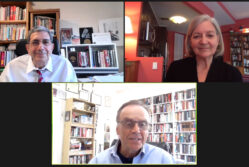Event Coverage Highlight

Women Photojournalists Showcase Craft and Career
By Chad Bouchard
On Sept. 7, the OPC and Columbia Journalism School hosted an evening with four accomplished female photojournalists to see examples of their in-depth documentary work and get behind-the-scenes insight about their career path, creative process, challenges in the field, and how they were able to gain close access to their subjects.
Kirsten Luce, who spent nearly a decade documenting immigration on both sides of the U.S.-Mexico border, recalled covering the story for her experience from 2006 to 2008 working for a small newspaper, The Monitor, in McAllen, Texas, before the nearby border had become such a large news story. She said by the time she returned to report for The New York Times in 2013, it had become the busiest corridor for human and drug trafficking in the U.S.
“I had full access to the border patrol, we had our own PR person, and we were allowed to ask questions and we got top level information. This was a real game changer for me.”
Using this increased access, Luce was able to shoot many angles of the story, from life at border patrol recruitment centers to aerial photos of migrants on the run, taken from border patrol helicopters that were paid for with a huge infusion of federal funds.
“In the summer of 2014 we saw a huge spike in Central American migrants, women and children mostly, that were showing up and presenting themselves asking for asylum. This was unprecedented.”
Glenna Gordon, a documentary photographer who has worked for outlets including The New York Times Magazine, TIME magazine, The Wall Street Journal, and many other outlets, showed selections from her project, titled “Nigeria Ever After,” which documented weddings in Nigeria.
The nature of the project made for unusually easy access to subjects, she said.
“It’s amazing when you show up at someone’s best day, when everybody looks their best, people really want to be photographed.”
From there, she began to photograph a community of Muslim women who write popular romance novels in the West African language of Hausa. Some of the novels were pretty “subversive,” Gordon said, touching on social subjects such as child marriage and human trafficking. That project became her book, Diagram of the Heart. It was chosen as one of The New York Times Magazine’s best photo books of the year.
“I had been so afraid of Northern Nigeria before I went there,” she said “and all that people hear about is Boko Haram, and that’s a very real issue, but it’s also not the only thing that’s happening. So it was a pretty wonderful opportunity for me to do something entirely different.”
Malin Fezehai, a Swedish/Eritrean photographer whose ongoing work examines the plight of displaced people around the world, spoke about her project to document the lives of some 50,000 African refugees in Israel, mainly from Sudan and Eritrea.
Using a letter from an editor at TIME magazine, she was able to get access to an “open” detention center in the Nagev desert called Holot, where residents have to check in a few times each day, a the nearest town is an hour away by car.
“So you basically just have these guys wandering the desert not really knowing what to do with themselves,” she said. “A lot of the refugees already put themselves in high debt, because a lot of them were captured before they entered Israel and had to pay ransoms of up to $20,000.”
Israel usually gives the refugees only two options – to be deported to country of origin, or to go to a third country in Africa, like Uganda or Rwanda.
Adriana Zehbrauskas, a Brazilian photojournalist based in Mexico, talked about her experience covering the 2014 disappearance of 43 students from the Ayotzinapa teacher’s rural school, who are presumed to be kidnapped by police and sold to narco groups. She followed the story for The New York Times, Buzzfeed News and other media for a year
While talking to family members of the missing, she discovered that most of the families’ images were kept only in digital form on phones, and many had already been lost.
“So these people disappeared not once, but twice. They are disappearing from memories, too. In three or four years, there’s not even going to be proof that these people existed.”
With help from a Getty Images Instagram Grant, she began to take family portraits and print had copies on site for the subjects to keep. She found this project, called “Family Matters,” to be very rewarding.
“When you’re not a threat and you’re giving back something, it was very liberating for me to work like this,” she said. “I was happy, because they have the pictures. I’ve done my job.”
The panel was moderated by Nina Berman, associate professor of Journalism, and Alice Gabriner, international photo editor for TIME magazine.



